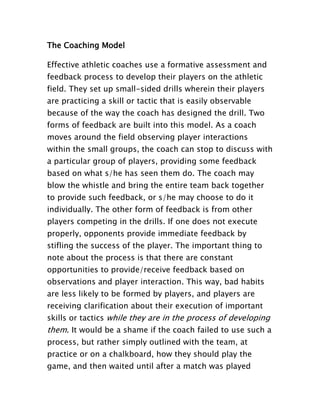The coaching model
•Download as DOCX, PDF•
0 likes•127 views
The coaching model provides constant feedback through small drills and exercises that allow coaches to observe players and provide immediate feedback. Coaches can stop groups to discuss performance or bring the whole team together. Players also receive feedback from opponents during drills if skills are not executed properly. This formative assessment process helps players improve skills and avoid forming bad habits, unlike a model where coaches only provide feedback after games or tests when it is too late to impact the outcome.
Report
Share
Report
Share

Recommended
Recommended
More Related Content
Viewers also liked
Viewers also liked (6)
Similar to The coaching model
Similar to The coaching model (20)
Part II After reading Chapters 1-2, please describe evaluation. .docx

Part II After reading Chapters 1-2, please describe evaluation. .docx
(Wolf) The Rest of the 7 Student-Centered Strategies of Assessment for Learning 

(Wolf) The Rest of the 7 Student-Centered Strategies of Assessment for Learning
Physical literacy provincial curriculum - whole - print ready

Physical literacy provincial curriculum - whole - print ready
Recently uploaded
The Author of this document is
Dr. Abdulfatah A. SalemOperations Management - Book1.p - Dr. Abdulfatah A. Salem

Operations Management - Book1.p - Dr. Abdulfatah A. SalemArab Academy for Science, Technology and Maritime Transport
https://app.box.com/s/tkvuef7ygq0mecwlj72eucr4g9d3ljcs50 ĐỀ LUYỆN THI IOE LỚP 9 - NĂM HỌC 2022-2023 (CÓ LINK HÌNH, FILE AUDIO VÀ ĐÁ...

50 ĐỀ LUYỆN THI IOE LỚP 9 - NĂM HỌC 2022-2023 (CÓ LINK HÌNH, FILE AUDIO VÀ ĐÁ...Nguyen Thanh Tu Collection
Recently uploaded (20)
Students, digital devices and success - Andreas Schleicher - 27 May 2024..pptx

Students, digital devices and success - Andreas Schleicher - 27 May 2024..pptx
Basic phrases for greeting and assisting costumers

Basic phrases for greeting and assisting costumers
Operations Management - Book1.p - Dr. Abdulfatah A. Salem

Operations Management - Book1.p - Dr. Abdulfatah A. Salem
Salient features of Environment protection Act 1986.pptx

Salient features of Environment protection Act 1986.pptx
50 ĐỀ LUYỆN THI IOE LỚP 9 - NĂM HỌC 2022-2023 (CÓ LINK HÌNH, FILE AUDIO VÀ ĐÁ...

50 ĐỀ LUYỆN THI IOE LỚP 9 - NĂM HỌC 2022-2023 (CÓ LINK HÌNH, FILE AUDIO VÀ ĐÁ...
The Benefits and Challenges of Open Educational Resources

The Benefits and Challenges of Open Educational Resources
Home assignment II on Spectroscopy 2024 Answers.pdf

Home assignment II on Spectroscopy 2024 Answers.pdf
Benefits and Challenges of Using Open Educational Resources

Benefits and Challenges of Using Open Educational Resources
MARUTI SUZUKI- A Successful Joint Venture in India.pptx

MARUTI SUZUKI- A Successful Joint Venture in India.pptx
The coaching model
- 1. The Coaching Model Effective athletic coaches use a formative assessment and feedback process to develop their players on the athletic field. They set up small-sided drills wherein their players are practicing a skill or tactic that is easily observable because of the way the coach has designed the drill. Two forms of feedback are built into this model. As a coach moves around the field observing player interactions within the small groups, the coach can stop to discuss with a particular group of players, providing some feedback based on what s/he has seen them do. The coach may blow the whistle and bring the entire team back together to provide such feedback, or s/he may choose to do it individually. The other form of feedback is from other players competing in the drills. If one does not execute properly, opponents provide immediate feedback by stifling the success of the player. The important thing to note about the process is that there are constant opportunities to provide/receive feedback based on observations and player interaction. This way, bad habits are less likely to be formed by players, and players are receiving clarification about their execution of important skills or tactics while they are in the process of developing them. It would be a shame if the coach failed to use such a process, but rather simply outlined with the team, at practice or on a chalkboard, how they should play the game, and then waited until after a match was played
- 2. against another team to provide feedback on how the players executed the plan that had been discussed. Such an assessment and feedback process would be executed too late to affect the outcome of the match. However, in a classroom in which instruction takes place, leading only to a quiz or a test of student mastery of the subject matter, the exact same process may be occurring – instruction followed by a summative assessment leading to a grade that is a measure of success or failure – too late to make a difference.